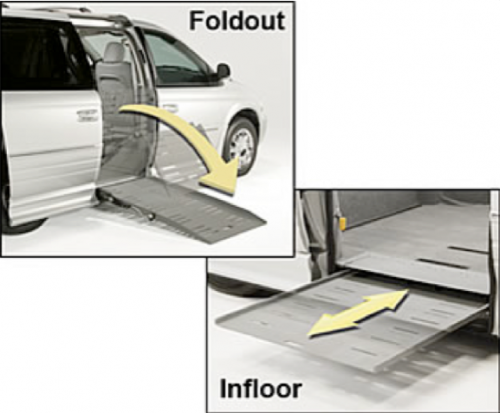
There are two types of wheelchair ramps, the in-floor ramp and the fold out ramp.
In-floor ramps are stored inside the floor of the van so that it is out of the way and allows more access space inside the cabin.
The Pros of The In-Floor Ramp:
- With no ramp in the doorway, passengers who are not in wheelchairs can enter and exit the vehicle without having to deploy the ramp.
- If you’d been bothered by the foldout ramp interfering with the front passenger seat reclining, that issue is eliminated with an in-floor ramp.
- Out of sight, out of mind! An in-floor ramp is completely concealed, so the interior looks closer than ever to that of a standard Vehicle.
The Cons of The In-Floor Ramp:
- The in-floor ramp has a slightly higher ramp angle compared to the foldout.
- Deploying an in-floor ramp onto a high curb could be a problem.
- An in-floor ramp may require more maintenance because the ramp tends to collect more debris.
Fold out ramps are stored folded up inside of the cabin which reduces the Cabin space, but does allow a lower
The Pro’s of The Fold Out Ramp:
- If you pull alongside a curb, it’s very easy to deploy a foldout ramp onto the sidewalk.
- In the case of an emergency, a wheelchair user can always push a foldout ramp until it deploys.
- Because the ramp is stored upright, less debris is able to get trapped and result in maintenance issues.
- Compared to the in-floor option, the foldout conversions have a lower ramp angle
The Cons of The Fold Out Ramp:
- Because the foldout ramp is housed in the doorway when stored, it takes up a small amount of interior space.
- The ramp can limit the front passenger seat from fully extending in a reclined position.
- In order to enter or exit on the ramp side of the vehicle, the ramp must be deployed.
You Have Other Choices, Too
Side Entry Ramp
At the risk of stating the obvious, the side entry ramp deploys from the side of the van rather than the back. The side entry ramp is deployed after the power-operated door on the side of the van slides open. Ramps can be automatically activated or manually opened and closed. For maximum safety, a power ramp should have a manual override in case of a power failure. All AMS side entry ramps are automated, with a manual override, and operation by remote control or controls inside and outside the door.
A side ramp can present a problem if you park in a two-car garage or in a non-handicap-accessible parking space, because you won’t have enough room to deploy the ramp properly. That said, they work beautifully in handicap parking spaces and won’t require you to open the ramp into oncoming traffic.
Rear Entry Ramp
Usually less costly than a side ramp conversion, the rear entry ramp wheelchair van deploys from the back of the van and is typically better suited for the wheelchair user who prefers to sit in the middle or back of the vehicle. Manual operation is the standard for rear entry ramps, which accounts for the lower cost, but automated rear entry ramps are available. Long-channel rear entry ramps can accommodate two wheelchair users in a minivan. Rear entry ramps can be hazardous in some parking situations if you have to deploy the ramp into a lane of traffic.
Portable Ramp
A lightweight, portable ramp offers flexibility in that you can use it for vehicle access as well as access to homes and buildings without handicap access. A portable ramp includes the same safety features (non-slip surface, side guards) as a permanently installed ramp, and these ramps typically fold up for easy portability.
Channel/Track Ramps
Instead of one wide ramp, economical channel or track ramps have two ramps with slip-proof channels, with each one wide enough to accommodate one wheel of a wheelchair. Also portable, track ramps can be adjusted to accommodate wheelchairs of any width simply by spreading them further apart.
What to Look For in a Wheelchair Ramp
Wheelchair accessible ramp designs vary, but there are a few things to look for in a ramp that affect your safety and ease of use. As always, price is a factor. That said, some of these features are, or should be, non-negotiable.
Non-Slip Surface
Also called an anti-slip surface or non-skid surface, a non-slip surface can be painted on or applied, like a rubberized coating. The need for a non-slip surface is indisputable, and most wheelchair van ramps are treated in some way to prevent slips and skids.
Sufficient Width
Wheelchairs come in different widths, and so do accessible van ramps. Make sure the ramp on your chosen van is more than wide enough to accommodate your wheelchair.
Side Guard/Lip Side guards (or lips) on either side of the ramp help prevent your wheelchair from falling over the edge of the ramp during entry or exit.
Maximum Weight
Wheelchair ramps have weight limits, and they vary, though most ramps can handle several hundred pounds. Always ask. Take both your weight plus the weight of the wheelchair into consideration.
Degree of Incline
A lower incline or slope means an easier climb up the ramp. The ADA recommends a 2:12 slope, which means every 2″ of vertical rise requires one foot of ramp (9.5 degrees of incline).
Manual/Motorized
An onboard ramp can be manually operated or automated to deploy and retract at the push of a button. An automated ramp adds to the price of the conversion; if you choose an automated ramp, make sure it has manual back-up. If, for some reason, the vehicle loses power, you’ll still be able to enter and exit.
